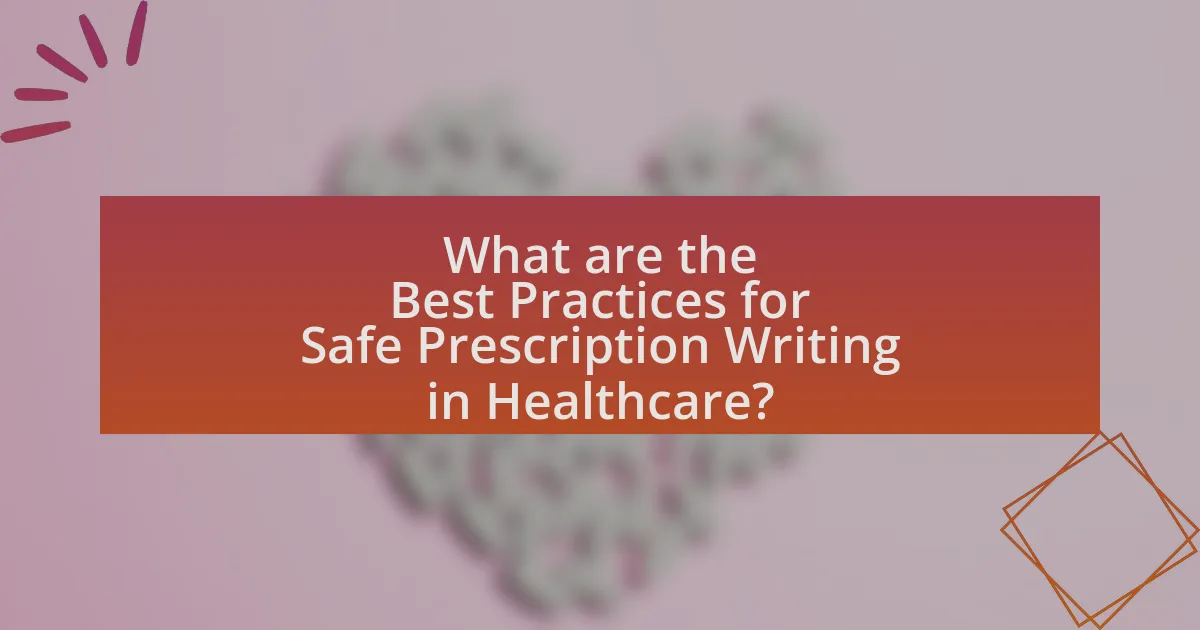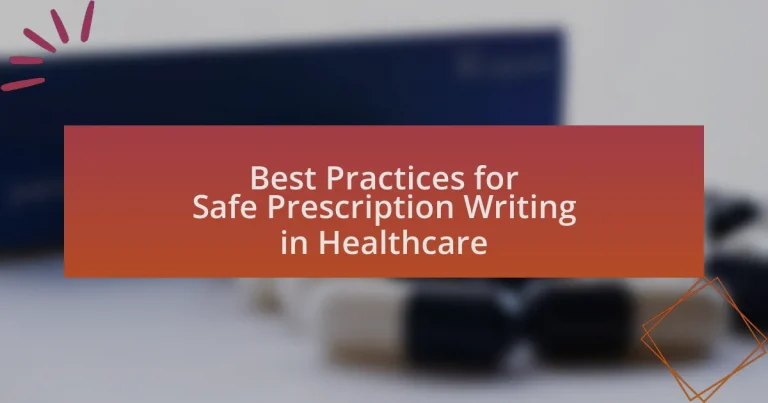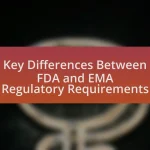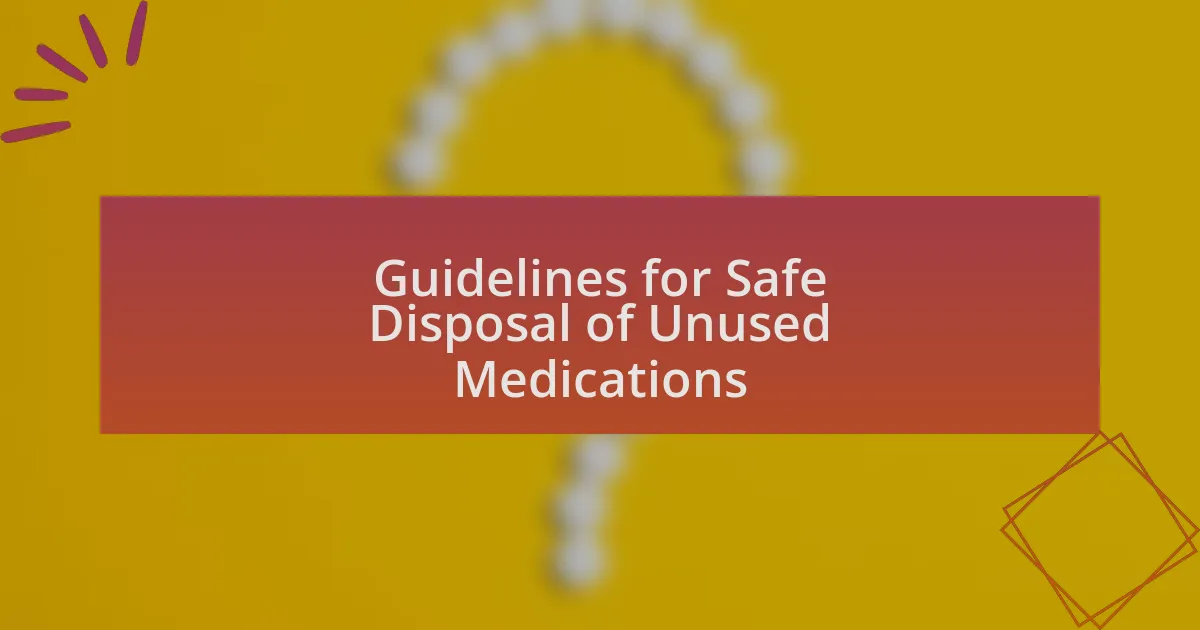The article focuses on best practices for safe prescription writing in healthcare, emphasizing the importance of clear handwriting, avoidance of ambiguous abbreviations, and inclusion of essential patient information to prevent medication errors. It highlights the significant risks associated with unsafe prescription practices, including adverse drug reactions and increased healthcare costs, while underscoring how accurate prescriptions can improve patient outcomes. Key elements of a prescription, legal considerations, and the role of technology in enhancing prescription safety are also discussed, along with strategies to overcome common challenges in prescription writing. Overall, the article serves as a comprehensive guide to ensuring safe and effective medication use in healthcare settings.
What are the Best Practices for Safe Prescription Writing in Healthcare?

The best practices for safe prescription writing in healthcare include using clear and legible handwriting, avoiding abbreviations that can lead to misinterpretation, and ensuring that all necessary patient information is included. Clear handwriting reduces the risk of errors due to misreading, while avoiding ambiguous abbreviations minimizes confusion. Additionally, including the patient’s full name, date of birth, and relevant medical history helps pharmacists verify the appropriateness of the medication. According to the Institute for Safe Medication Practices, nearly 1.3 million people are injured each year in the U.S. due to medication errors, highlighting the critical importance of these practices in preventing harm.
Why is safe prescription writing important in healthcare?
Safe prescription writing is crucial in healthcare to prevent medication errors that can lead to adverse drug events. Accurate prescriptions ensure that patients receive the correct medication, dosage, and instructions, thereby minimizing the risk of harmful interactions and side effects. According to the Institute of Medicine, medication errors harm at least 1.5 million people annually in the United States, highlighting the need for precise and clear prescription practices. Safe prescription writing not only protects patient safety but also enhances the overall quality of care in healthcare settings.
What are the potential risks associated with unsafe prescription practices?
Unsafe prescription practices can lead to significant risks, including medication errors, adverse drug reactions, and increased healthcare costs. Medication errors, such as incorrect dosages or wrong medications, can result in serious health complications or even fatalities. Adverse drug reactions may occur when patients receive medications that interact negatively with their existing prescriptions or health conditions, leading to hospitalization or long-term health issues. Furthermore, these unsafe practices can burden healthcare systems with additional costs due to the need for corrective treatments and extended patient care. According to the Institute of Medicine, medication errors harm at least 1.5 million people annually in the United States, highlighting the critical need for safe prescription practices.
How can safe prescription writing improve patient outcomes?
Safe prescription writing can significantly improve patient outcomes by reducing medication errors and enhancing adherence to treatment plans. When prescriptions are clearly written and accurately reflect the patient’s needs, the likelihood of misunderstandings or misinterpretations by pharmacists and patients decreases. Research indicates that clear and standardized prescription formats can lead to a 30% reduction in medication errors, as evidenced by a study published in the Journal of Patient Safety. This reduction in errors directly correlates with improved patient safety, better therapeutic effectiveness, and overall satisfaction with care.
What key elements should be included in a prescription?
A prescription should include the following key elements: patient information, date, medication name, dosage, route of administration, frequency, quantity, and prescriber information. Patient information ensures the medication is intended for the correct individual, while the date indicates when the prescription was written, which is crucial for validity. The medication name specifies the drug to be dispensed, and the dosage provides the amount to be taken. The route of administration details how the medication should be taken, and frequency indicates how often it should be administered. The quantity specifies how much medication is to be dispensed, and prescriber information identifies the healthcare professional responsible for the prescription. These elements are essential for ensuring safe and effective medication use, as outlined by the American Medical Association’s guidelines on prescription writing.
What information is essential for patient identification on a prescription?
Essential information for patient identification on a prescription includes the patient’s full name, date of birth, and address. This information is critical to ensure that the medication is dispensed to the correct individual and to avoid potential medication errors. Accurate patient identification helps healthcare providers verify the patient’s identity and medical history, which is essential for safe prescribing practices.
How should medication details be accurately documented?
Medication details should be accurately documented by ensuring that all relevant information is clearly recorded in the patient’s medical record. This includes the medication name, dosage, route of administration, frequency, duration of therapy, and any special instructions. Accurate documentation is critical for preventing medication errors, as studies indicate that clear and comprehensive records can reduce the risk of adverse drug events by up to 50%. Additionally, using standardized formats and electronic health records can enhance the clarity and accessibility of medication information, further supporting patient safety and continuity of care.
How can healthcare professionals ensure clarity in prescriptions?
Healthcare professionals can ensure clarity in prescriptions by using standardized abbreviations and clear, legible handwriting. Standardized abbreviations reduce the risk of misinterpretation, while legible handwriting minimizes confusion regarding medication names and dosages. According to a study published in the Journal of the American Medical Association, illegible handwriting is a significant contributor to medication errors, highlighting the importance of clarity in prescription writing. Additionally, incorporating electronic prescribing systems can further enhance clarity by eliminating handwriting issues and providing built-in checks for drug interactions and allergies.
What role does legibility play in prescription writing?
Legibility is crucial in prescription writing as it directly impacts patient safety and medication accuracy. When prescriptions are clearly written, healthcare providers can accurately interpret the medication, dosage, and instructions, reducing the risk of errors. Studies have shown that illegible handwriting is a significant contributor to medication errors, with one report indicating that nearly 30% of prescriptions are misinterpreted due to poor legibility. Therefore, ensuring legibility in prescriptions is essential for effective communication among healthcare professionals and for safeguarding patient health.
How can abbreviations and symbols lead to errors in prescriptions?
Abbreviations and symbols can lead to errors in prescriptions by causing misinterpretation of medication instructions. For instance, the abbreviation “U” for units can be confused with the number “0,” leading to a tenfold dosing error. The Institute for Safe Medication Practices reported that such misinterpretations have resulted in serious patient harm, highlighting the critical need for clarity in prescription writing. Additionally, symbols like “>” and “<” can be misread, further complicating dosage instructions. These examples illustrate how reliance on abbreviations and symbols without standardization can compromise patient safety.
What are the legal considerations in prescription writing?
Legal considerations in prescription writing include adherence to federal and state regulations, ensuring the prescription is written for a legitimate medical purpose, and maintaining accurate patient records. Healthcare providers must comply with the Controlled Substances Act, which regulates the prescribing of narcotics and other controlled substances, requiring specific documentation and patient evaluation. Additionally, prescribers must verify patient identity and allergies, and ensure that prescriptions are legible and contain all necessary information, such as dosage, frequency, and duration. Failure to comply with these legal standards can result in disciplinary action, including loss of medical license or legal penalties.
What regulations govern prescription writing in different regions?
Regulations governing prescription writing vary significantly across different regions, primarily influenced by national laws and healthcare policies. In the United States, the Drug Enforcement Administration (DEA) regulates controlled substances, requiring specific formats for prescriptions, while individual states may impose additional requirements, such as electronic prescribing mandates. In the European Union, the European Medicines Agency (EMA) oversees medication regulations, and each member state has its own laws regarding prescription practices, often emphasizing electronic prescriptions and patient safety. In Canada, provincial regulatory bodies set guidelines for prescription writing, focusing on the safe use of medications and the responsibilities of healthcare providers. These regulations are designed to ensure patient safety, prevent misuse of medications, and promote effective communication among healthcare professionals.
How can healthcare providers stay compliant with prescription laws?
Healthcare providers can stay compliant with prescription laws by regularly educating themselves on federal and state regulations governing prescriptions. This includes understanding the Controlled Substances Act, which categorizes drugs and outlines prescribing limits, as well as state-specific laws that may impose additional requirements. Compliance can be further ensured by implementing electronic prescribing systems that include built-in checks for drug interactions and dosage limits, thereby reducing the risk of errors. Regular audits of prescribing practices and maintaining accurate patient records also support adherence to legal standards. According to the National Institute on Drug Abuse, proper education and technology use can significantly decrease prescription errors and enhance patient safety.
How can technology enhance safe prescription writing?
Technology enhances safe prescription writing by implementing electronic prescribing systems that reduce errors associated with handwritten prescriptions. These systems utilize standardized formats and built-in checks for drug interactions, allergies, and dosage errors, significantly decreasing the likelihood of mistakes. According to a study published in the Journal of the American Medical Informatics Association, electronic prescriptions have been shown to reduce medication errors by up to 50%. Additionally, features such as real-time access to patient medication histories and decision support tools further bolster the safety and accuracy of prescriptions, ensuring that healthcare providers make informed decisions.
What are the benefits of electronic prescribing systems?
Electronic prescribing systems enhance medication safety and efficiency in healthcare. These systems reduce errors associated with handwritten prescriptions, as studies indicate that electronic prescriptions can decrease medication errors by up to 50%. Additionally, they streamline the prescribing process, allowing healthcare providers to send prescriptions directly to pharmacies, which improves patient adherence and reduces wait times. Electronic prescribing also facilitates access to patient medication histories, enabling providers to make informed decisions and avoid harmful drug interactions. Furthermore, these systems often include clinical decision support tools that alert prescribers to potential issues, further enhancing patient safety.
How can decision support tools minimize prescription errors?
Decision support tools minimize prescription errors by providing real-time alerts and recommendations based on patient data and medication interactions. These tools analyze prescriptions against established clinical guidelines and patient-specific factors, such as allergies and current medications, to identify potential errors before they occur. For instance, a study published in the Journal of the American Medical Informatics Association found that implementing clinical decision support systems reduced medication errors by 55%. This evidence demonstrates that decision support tools significantly enhance the safety and accuracy of prescription writing in healthcare.
What training and resources are available for healthcare professionals?
Healthcare professionals have access to various training programs and resources focused on safe prescription writing. These include continuing medical education (CME) courses, online training modules, and workshops specifically designed to enhance knowledge about medication management and prescription safety. For instance, the American Medical Association offers resources and guidelines that emphasize best practices in prescribing, including the importance of understanding drug interactions and patient history. Additionally, organizations like the Institute for Safe Medication Practices provide educational materials and tools to help healthcare providers minimize prescribing errors. These resources are essential for ensuring that healthcare professionals stay informed about the latest standards and practices in safe prescription writing.
What educational programs focus on safe prescription practices?
Educational programs that focus on safe prescription practices include the American Medical Association’s Prescribing Safety Program and the Centers for Disease Control and Prevention’s (CDC) Opioid Prescribing Guidelines training. These programs aim to educate healthcare professionals on the importance of responsible prescribing, risk assessment, and patient safety. The American Medical Association’s program provides resources and training modules that emphasize best practices in prescribing medications, while the CDC’s guidelines offer evidence-based recommendations to reduce opioid misuse and enhance patient care.
How can healthcare professionals access updated guidelines and resources?
Healthcare professionals can access updated guidelines and resources through reputable medical organizations, government health agencies, and online databases. Organizations such as the American Medical Association and the Centers for Disease Control and Prevention regularly publish updated clinical guidelines and resources that are essential for safe prescription writing. Additionally, platforms like PubMed and the National Guidelines Clearinghouse provide access to a wide range of peer-reviewed articles and evidence-based guidelines. These resources are crucial for ensuring that healthcare professionals stay informed about the latest best practices and recommendations in their field.
What are the common challenges in safe prescription writing?
Common challenges in safe prescription writing include illegible handwriting, which can lead to medication errors, and the use of ambiguous abbreviations that may be misinterpreted. Additionally, inadequate patient information, such as allergies or current medications, can result in harmful drug interactions. A study published in the Journal of Patient Safety found that nearly 50% of medication errors stem from poor communication during the prescribing process. Furthermore, the lack of standardized protocols for electronic prescriptions can contribute to inconsistencies and errors. These factors highlight the critical need for clear communication and adherence to best practices in prescription writing.
How can communication barriers affect prescription safety?
Communication barriers can significantly compromise prescription safety by leading to misunderstandings between healthcare providers and patients. When there is a lack of clarity in conveying medication instructions, patients may misinterpret dosages, frequency, or the purpose of the medication, resulting in medication errors. For instance, a study published in the Journal of Patient Safety found that poor communication was a contributing factor in 70% of medication errors reported in hospitals. This highlights the critical need for effective communication strategies to ensure that patients fully understand their prescriptions, thereby enhancing safety and adherence to treatment regimens.
What strategies can be implemented to overcome these challenges?
To overcome challenges in safe prescription writing in healthcare, implementing standardized protocols is essential. Standardized protocols, such as utilizing electronic prescribing systems, can significantly reduce errors associated with handwritten prescriptions. Research indicates that electronic prescribing can decrease medication errors by up to 50%, as it minimizes misinterpretation and enhances clarity. Additionally, regular training sessions for healthcare professionals on best practices in prescription writing can further mitigate risks. Studies show that continuous education improves adherence to safety protocols, leading to better patient outcomes. Lastly, incorporating a double-check system, where another qualified professional reviews prescriptions before they are finalized, can serve as an effective safeguard against potential mistakes.
What practical tips can improve prescription writing safety?
To improve prescription writing safety, healthcare providers should utilize standardized templates and electronic prescribing systems. Standardized templates reduce ambiguity by providing clear fields for medication name, dosage, and instructions, which minimizes the risk of misinterpretation. Electronic prescribing systems enhance safety by automatically checking for drug interactions, allergies, and contraindications, thereby reducing the likelihood of errors. Research indicates that the implementation of electronic prescribing can decrease medication errors by up to 50%, highlighting its effectiveness in improving prescription safety.





